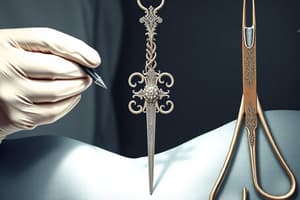Podcast
Questions and Answers
What is the primary function of a Mayo-Hegar Needle Holder?
What is the primary function of a Mayo-Hegar Needle Holder?
- To secure heavier suture needles (correct)
- To cut sutures during procedures
- To hold delicate sutures in place
- To remove sutures after procedures
In what type of procedures would shorter lengths of the Mayo-Hegar Needle Holder typically be used?
In what type of procedures would shorter lengths of the Mayo-Hegar Needle Holder typically be used?
- Gynecological procedures (correct)
- Neurological procedures
- Cardiac procedures
- Orthopedic procedures
What feature of the Mayo-Hegar Needle Holder helps maximize control and precision?
What feature of the Mayo-Hegar Needle Holder helps maximize control and precision?
- Tungsten carbide inserts (correct)
- Wide jaw with rounded tips
- Smooth handles
- Short length
Why are Suture scissors also known as stitch scissors?
Why are Suture scissors also known as stitch scissors?
What is the role of the small hook shaped tip on one blade of Suture scissors?
What is the role of the small hook shaped tip on one blade of Suture scissors?
When should Suture scissors not be used?
When should Suture scissors not be used?
What should be inspected in Suture scissors to ensure their proper functioning?
What should be inspected in Suture scissors to ensure their proper functioning?
Flashcards are hidden until you start studying
Study Notes
Tungsten Carbide Iris Scissors
- OR Grade - 5 1⁄2” straight, smooth, sharp/sharp tips
- Used for ophthalmic procedures, emergency rooms, OB/GYN, and dermatologic procedures
- Ideal for detailed dissection of fine tissue and fine suture removal
- Provides an exceptionally durable and hard cutting edge, staying sharp for a longer period
Hartmann Mosquito Forceps
- OR Grade - 4 1⁄2” straight, smooth, sharp/sharp tips
- Used as both a hemostat and for fine tissue dissection in shallow wounds or procedures
- Commonly used in plastic and vascular surgeries, pediatric and ophthalmologic procedures
- Jaws are half serrated, and are 1/3 the length of the shanks; serrations are 1⁄2 the length of the jaws
Rochester Pean Halsted Mosquito Forceps
- OR Grade - 5 1⁄2” straight, serrated tips
- Clamps or occludes larger tissue and vessels to control bleeding
- Available in multiple lengths; curved or straight, with full horizontal serrations on the jaws
- A versatile instrument used in multiple procedures
Crile Hemostat
- OR Grade - 6 1⁄4” curved, serrated
- Most commonly used for clamping blood vessels or tissue before cauterization or ligation
- May also be used for soft tissue dissection
- Curved or straight with serrated tips and various lengths
Thumb Forceps
- OR Grade - 5 1⁄2” curved, serrated jaws
- Used for holding dressing materials such as cotton and gauze during surgical procedures
- Used for changing dressings or packing wounds
Dressing Forceps
- OR Grade - 6” straight, serrated
- Used for manipulating various types of tissues in a multitude of procedures
- Used for wound closure
- Available in several lengths to accommodate specific procedures and user preference
Studying That Suits You
Use AI to generate personalized quizzes and flashcards to suit your learning preferences.




